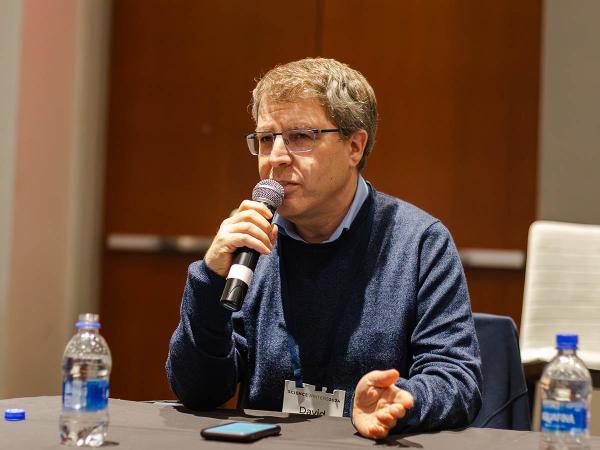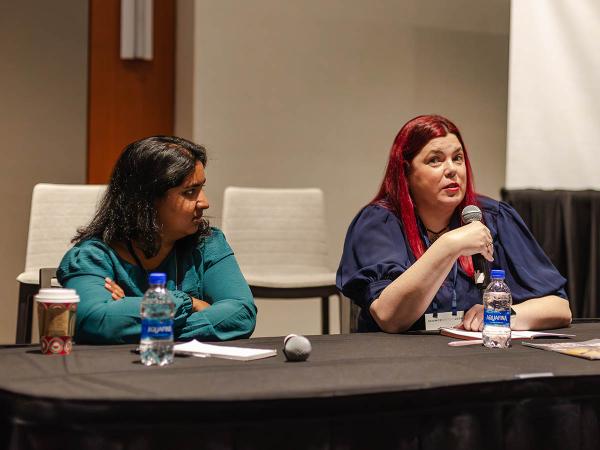Story by Lily Stewart
Photography by Sophie Hartley
Pitching can feel like a deeply personal and private task. Although the goal of a pitch is to get an editor’s eyes on the story — and, hopefully, to convince them to accept it — few writers expect to receive live feedback in front of an audience. That is, except for the brave pitchers at ScienceWriters2024’s in-person Pitch Slam, where writers shared their ideas face-to-face not just with editors, but with dozens of witnesses.
Four panelists sat at the front of a large conference room at the Raleigh Convention Center, facing the expectant audience. The panelists — all editors from popular science magazines — were there to provide feedback to courageous writers. Each writer had one minute to present their story, followed by the panel’s thoughts on the pitch.
Before the pitching commenced, each editor explained their publication’s interests. David Ehrenstein, a senior editor at Physics Magazine, explained that he was, predictably, interested in all things physics, especially quantum physics. Rosie Mestel, the executive editor at Knowable Magazine, was looking for “curiosity-driven” stories and shorter pieces under 1,200 words.

David Ehrenstein reacts to an audience pitch at Pitch Slam 2024. (Sophia Hartley for NASW)
Shraddha Chakradhar, deputy news editor for diversity at Science, called for research-grounded stories that go beyond EurekAlert-distributed alerts of new research articles. She was especially interested in stories that had to do with reproductive health, A.I., physical sciences, health disparities, and science and society. Finally, Sarah Zielinski, the editor of Science News Explores, requested stories targeted to kids, tweens, and teens and warned writers to steer clear of topics that were “just not relatable” to that audience, such as Alzheimer’s or types of cancer that mostly affect adults.
After the panel introductions, Sarah Scoles, a freelance science journalist and moderator of the event, warned pitchers against going over their allotted time. “It’s awkward for me, it’s awkward for you, and it’s awkward for Virginia,” Scoles said, motioning to Virginia Gewin, a co-organizer of the event, who gently demonstrated the bell that would ring to warn the pitchers their time was up.
With some healthy coaxing from Scoles, volunteers began to step up to the microphone. They ranged from undergraduate students to university professors whose pitches varied from carefully written to more extemporaneous. Some professed their nervousness, while others dived straight into their pitches. The audience clapped after each turn, contributing to an atmosphere that was as inviting as possible for a nerve-wracking situation.
“I don’t know if we’ve ever clapped before. It’s an emergent phenomenon,” Scoles said.

Shraddhar Chakradha listens to fellow judge Sarah Zielinski react to an audience pitch at Pitch Slam 2024. (Sophia Hartley for NASW)
After one hour and three bell rings, 10 people had pitched their ideas, and one person had used their turn to ask a question. General feedback included advice on finding stories rather than just topics; pitching multimedia pieces; and tailoring stories to specific audiences. Mestel pushed writers to consider how international stories could connect to U.S. audiences. Chakradhar asked writers to find new angles for topics that have already received extensive coverage. Zielinksi pointed out stories that were a bit too adult for her young audience. Ehrenstein, of course, requested more physics.
Additionally, a handful of writers whose stories were difficult to condense into an 800-word piece received the advice to pursue their ideas as books, though the panelists acknowledged they were not book editors.
The Pitch Slam rounded out with a booming round of applause and — seemingly — some sighs of relief from the amped-up participants. Even for audience members who simply observed, the event’s attendees left with a better understanding of what the featured outlets were looking for and how to craft strong, eye-catching pitches.
A virtual edition of Pitch Slam 2024 was held on Oct. 18 organized by Gewin, Scoles, and Robin Berghaus, who moderated. The editors lineup then featured Jess Stahl of Grist (appearing for Katherine Bagley), Maddie Oatman of Mother Jones, Paige Vega of Vox, and Sarah Laskow of The Atlantic.

A packed conference hall listens in to the judging panel at Pitch Slam 2024 in Raleigh. (Ben Young Landis/NASW)
Lily Stewart is a freelance science writer and fact-checker based in Akron, Ohio. Her work has appeared in Undark, Atlas Obscura, Environmental Health News, and Great Lakes Now.
Sophie Hartley (@hartleys.bsky.social @sophienhartley) is a science journalist and photographer from Neenah, Wisc., reporting on land management, natural resources, and rural issues. Her work has appeared in outlets like The Boston Globe Magazine, Science News, bioGraphic, and Science Friday.
This ScienceWriters2024 conference coverage article was produced as part of the NASW Conference Support Grant awarded to Stewart and Hartley to attend the ScienceWriters2024 national conference. Find more 2024 conference coverage at www.nasw.org
A co-production of the National Association of Science Writers (NASW), the Council for the Advancement of Science Writing (CASW), and the Science Communicators of North Carolina (SCONC), the ScienceWriters2024 national conference featured an online portion Oct. 16-18, followed by an in-person portion held in Raleigh, N.C., Nov. 8-11. Follow the conversation via #SciWri24 on Bluesky and on LinkedIn.
Founded in 1934 with a mission to fight for the free flow of science news, NASW is an organization of ~2,400 professional journalists, authors, editors, producers, public information officers, students and people who write and produce material intended to inform the public about science, health, engineering, and technology. To learn more, visit www.nasw.org and follow NASW on LinkedIn and Bluesky. And join us in celebrating #NASW90th.
Credits: Reporting by Lily Stewart; edited by Ben Young Landis. Photography by Sophie Hartley; edited by Ben Young Landis.




